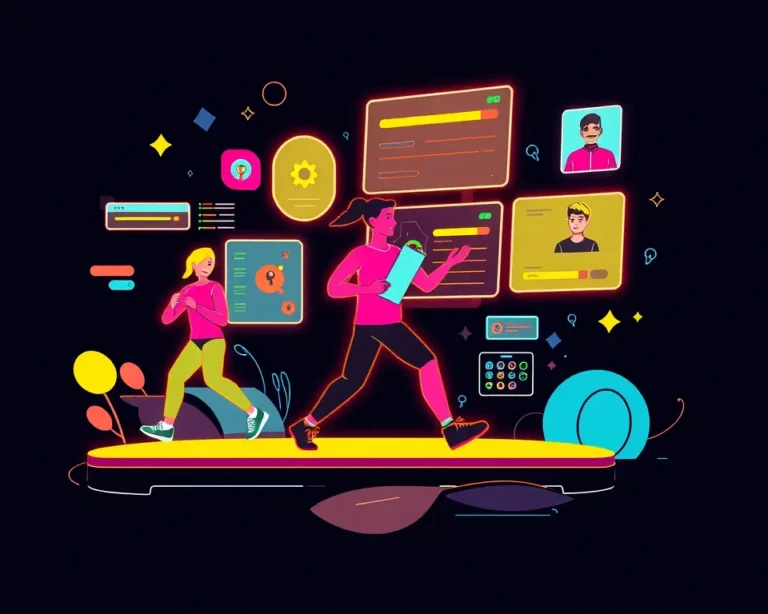Gamification has emerged as a powerful tool, transforming mundane activities into engaging experiences. This innovative approach is revolutionizing the fitness landscape, turning workouts into fun, addictive games. By incorporating game-like elements such as rewards, challenges, and competition, technology is making exercise more enticing and effective, helping people achieve their fitness goals while enjoying the process.
Why Gamify Fitness? Unlocking Motivation and Engagement
Gamification works by tapping into basic human desires for achievement, social interaction, and self-expression. By adding game elements to workouts, fitness apps and programs increase motivation, engagement, and adherence.
The Science Behind the Fun
Gamification leverages both intrinsic and extrinsic motivators to keep users engaged. Intrinsic motivation comes from the personal satisfaction of earning a badge or completing a challenge, while extrinsic motivation is driven by external rewards like points or discounts. This combination of internal and external factors makes workouts more enjoyable and helps build healthy habits.
Benefits for Users:
- Increased Motivation: Gamification provides a sense of progress and achievement, making users more driven to push harder and consistently participate in physical activities.
- Improved Fitness Levels: By making workouts enjoyable, gamification helps users stay consistent, leading to better fitness levels and performance.
- Enhanced Engagement: Gamified fitness apps encourage users to spend more time exercising, increasing their overall engagement with their fitness journey.
- Sense of Achievement: Earning rewards and tracking progress fosters a sense of accomplishment, boosting self-esteem and encouraging continued participation.
- Social Connection: Collaborative and competitive features create a sense of belonging and community, making the fitness experience more enjoyable and supportive.
- Personalized Experience: Gamification allows users to customize their fitness journeys, setting goals and tracking progress in a way that suits their individual needs and preferences.
- Better Mental Health: Gamified physical activity improves well-being, reduces stress, elevates mood, and enhances sleep quality.
Benefits for Gyms and App Developers:
- Increased User Retention: Gamification keeps users engaged, leading to higher retention rates and a stronger community.
- Stronger Community: Social features encourage users to invite friends, expanding the user base and fostering a sense of community.
- Positive Feedback Loops: Satisfied users are more likely to leave positive reviews and recommend the app to others, creating a positive feedback loop.
- Business Growth: By increasing client retention and member engagement, gamification can help gym and studio owners grow their businesses.
Key Gamification Features in Fitness Apps
Gamified fitness apps incorporate a variety of features to keep users motivated and engaged:
- Rewards and Incentives: Earning points, badges, or virtual trophies for completing workouts or achieving goals.
- Challenges and Competitions: Adding an element of competition through challenges, virtual races, and workout competitions.
- Leaderboards and Social Sharing: Ranking users based on their performance, encouraging friendly rivalry and allowing users to share their progress with friends.
- Progress Tracking and Feedback: Providing visual and tangible feedback on progress, helping users stay accountable and make informed decisions about their well-being.
- Storytelling and Virtual Adventures: Incorporating storytelling to make workouts more immersive, turning mundane tasks into exciting quests.
- Personalized Goals: Setting customized fitness journeys, where users set goals and track their progress in a way that suits their individual needs and preferences.
Real-World Examples of Gamified Fitness Apps
Several fitness apps have successfully integrated gamification to enhance user experience and drive results:
- Fitbit: Rewards users with badges for reaching milestones, such as completing a 5K run or achieving a weekly step goal.
- Strava: Allows users to compete with friends and track their running or cycling routes, turning solo activities into a communal experience.
- MyFitnessPal: Integrates gamified elements, such as setting goals and tracking progress through reports, to motivate continuous training.
- Zwift: Turns indoor cycling and running into a virtual experience, allowing users to train with others in virtual environments.
- Nike Training Club: Provides rewards and incentives for completing workouts, encouraging users to stay consistent.
- Weight Watchers: Adds badges and rewards for achieving milestones, challenges and competitions to create a friendly competitive environment, and leaderboards and rankings to motivate users.
- Zombies, Run!: Combines fitness tracking with storytelling, motivating users to run and collect supplies in a post-apocalyptic world.
- Supernatural: Offers a subscription-based virtual reality exercise experience, utilizing fitness in immersive games.
- Apple Watch Fitness: Apps use leaderboards, badges, and challenges to incentivize exercise, offering rewards like discounts on gear or wellness retreats
The Rise of Exergaming: Where Fitness Meets Gaming
Exergaming, or active video gaming, combines physical activity with video games, providing an enjoyable and practical approach to maintaining a healthy lifestyle. These games range from interactive sports simulations to dancing games, offering a unique way to combine physical activity with interactive gaming.
Types of Exergames:
- VR Fitness Games: Virtual reality games provide a completely realistic and interactive workout experience, immersing users in virtual environments and making exercise more exciting.
- AR Fitness Games: Augmented reality games blend virtual elements with the real world, creating interactive and dynamic experiences that can be enjoyed anywhere.
- Wearable Games: Fitness and health-focused wearables have transformed exercise into enjoyable gaming experiences, offering challenges, rewards, and achievements based on physical activities.
- Gesture-Based Games: Utilize motion-sensing technology to enable players to control the game using their body movements, making exercise more interactive and engaging.
Examples of Exergames:
- Just Dance: A dancing game that has players following on-screen visual cues in order to score points based on their rhythm and accuracy.
- Beat Saber: A VR game where players have to keep up with the beat of a song by swinging their arms to slash through multicolored blocks.
- Ring Fit Adventure: A Nintendo Switch game that combines fitness with adventure, allowing players to explore a virtual world while performing exercises.
- Home Sports: A mixed reality game that offers a collection of different sports that can be played in your living room.
- Thrill of the Fight 2: A VR game where you step into the ring as a fully customizable avatar, testing your skills and working up a serious sweat.
- Gorilla Tag: A quirky VR game where you become a monkey that has to climb, jump, and run from other gorillas, using a crazy movement method that utilizes your hands and arms.
Benefits of Exergaming:
- Increased Motivation: Exergames make exercise more engaging and enjoyable, helping users stay motivated and committed to their fitness goals.
- Improved Fitness Levels: By encouraging regular physical activity, exergaming can lead to improved fitness levels and better overall health.
- Accessibility and Inclusivity: Exergames are accessible to people of all fitness levels and ages, making fitness more approachable and less intimidating.
- Fun and Entertainment: Exergames take you into worlds where dragons are slain, quests are completed, and calories are burned, all without feeling like a workout.
Wearable Tech: Tracking, Motivating, and Connecting
Wearable technology, such as fitness trackers and smartwatches, plays a crucial role in gamified fitness by providing real-time data, personalized insights, and enhanced motivation.
How Wearable Tech Enhances Fitness:
- Real-Time Data: Wearables track everything from daily steps to calories burned, heart rate fluctuations, and sleep patterns, providing users with immediate feedback on their activity levels.
- Personalized Insights: By analyzing user data, wearables provide personalized insights into fitness trends and areas for improvement, helping users make informed decisions about their health.
- Goal Setting and Tracking: Wearables allow users to set fitness goals and track their progress, providing a sense of achievement and encouraging continued participation.
- Community and Social Connectivity: Most fitness trackers and apps allow users to share their progress, join challenges, and compete against friends or global communities, turning solo activities into a communal experience.
- Integration with Gamified Apps: Wearables seamlessly integrate with gamified fitness apps, enhancing the overall experience and providing users with a comprehensive fitness solution.
Examples of Wearable Tech in Fitness:
- Fitness Trackers: Devices like Fitbit track steps, calories burned, and sleep patterns, providing users with a comprehensive overview of their daily activity levels.
- Smartwatches: Smartwatches like Apple Watch offer advanced features such as heart rate monitoring, GPS tracking, and integration with fitness apps, providing users with real-time feedback during workouts.
- Smart Clothing and Biometric Wearables: Compression shirts with heart rate monitors or motion tracking embedded in shorts provide athletes with real-time biomechanical feedback, enabling them to optimize their performance and avoid injuries.
The Future of Gamified Fitness: Trends to Watch
The future of gamified fitness is bright, with several exciting trends on the horizon:
- AI-Powered Personalization: AI is being used to personalize fitness plans, adjust calorie targets based on activity, and suggest meal plans using real-time data.
- VR and AR Integration: Virtual and augmented reality are transforming exercise into immersive experiences, with virtual trainers providing real-time feedback and interactive training sessions.
- Gamification of Longevity: Apps are prioritizing quality of life over quick fixes, using gamification to encourage preventive screenings and healthy habits, rewarding users for early disease detection.
- Phygital Healthcare: Blending digital and human touch, health education is being delivered through mini-games, and community leaderboards are providing social reinforcement.
- Hybrid Fitness: Combining the convenience of at-home workouts with the energy of a gym environment, platforms like Peloton offer subscription services that can be incorporated at the gym and carried over to home workouts.
- Wearable Gaming: Integrating gaming features and experiences into wearable devices, such as smartwatches, AR glasses, fitness trackers, and VR headsets, offering a hands-free and interactive gaming experience.
Challenges and Limitations
While gamified fitness offers numerous benefits, it also has some challenges and limitations:
- Potential for Burnout: Over-reliance on rewards and competition can lead to burnout and decreased motivation over time.
- Data Privacy Concerns: Wearable devices and fitness apps collect vast amounts of personal data, raising concerns about privacy and security.
- Accessibility Issues: Some gamified fitness programs may not be accessible to people with disabilities or those who lack access to technology.
- Effectiveness Varies: The effectiveness of gamification varies depending on individual preferences and personality traits.
Conclusion: Embrace the Game-Changing Power of Tech in Fitness
Gamification is transforming the fitness landscape, making workouts more fun, engaging, and effective. By incorporating game-like elements, technology is helping people achieve their fitness goals while enjoying the process. Whether through fitness apps, exergaming, or wearable tech, the future of fitness is undoubtedly gamified. As technology continues to evolve, we can expect even more innovative and immersive ways to turn workouts into addictive games, helping people lead healthier and more active lives.







